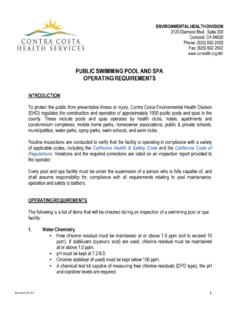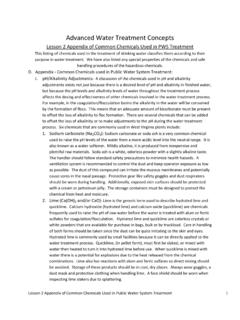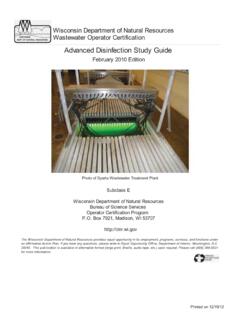Transcription of EPA 832-F-00-022 - September 2000
1 United StatesEnvironmental ProtectionAgencyOffice of WaterWashington, 832-F-00-022 September 2000 WastewaterTechnology Fact SheetDechlorinationDESCRIPTIOND echlorination is the process of removing residualchlorine from disinfected wastewater prior todischarge into the environment. Sulfur dioxide ismost commonly used for dechlorination and is themajor focus of this fact sheet. Some dechlorinationalternatives include carbon adsorption, sodiummetabisulfite, sodium bisulfite, and hydrogenperoxide. Sodium metabisulfite and sodiumbisulfite are mainly used in small facilities becausethese materials are more difficult to controlcompared to sulfur dioxide. Hydrogen peroxide isnot frequently used because it is dangerous tohandle (WEF, 1996).APPLICABILITYC hlorination has been used widely to disinfectwastewater prior to discharge since passage of the1972 Federal water Pollution Control Act(WPCA), (Finger et al.)
2 , 1985). In the first yearsfollowing the WPCA, disinfected wastewater withsignificant levels of residual chlorine was routinelydischarged into the receiving waters. It becameclear, however, that residual chlorine is toxic tomany kinds of aquatic life (see, for example,Mattice and Zittel, 1976, and Brungs, 1973).Moreover, the reaction of chlorine with organicmaterials in the water formed carcinogenictrihalomethanes and organochlorines (WEF andASCE, 1991). As a result, dechlorination wasinstituted to remove residual chlorine fromwastewater prior to discharge into sensitive minimizes the effect of potentiallytoxic disinfection byproducts by removing the freeor total combined chlorine residual remaining afterchlorination. Typically, dechlorination isaccomplished by adding sulfur dioxide or sulfitesalts ( , sodium sulfite, sodium bisulfite, orsodium metabisulfite).
3 Carbon adsorption is also aneffective dechlorination method, but is expensivecompared to other methods. Carbon adsorption isusually implemented when total dechlorination design criteria and monitoringrequirements for a particular region are determinedby the state regulatory agency. Typically, thetreatment plant s National Pollutant DischargeElimination System (NPDES) permit limits effluentchlorine residual and toxicity. Currently, manypermits require very low or non-detect chlorineresiduals, making dechlorination important alternative to dechlorination is toachieve disinfection without the use of means of disinfection, such as ozone orultraviolet disinfection, have also becomeincreasingly prevalent ( EPA, 1986; Blatchley, III, et al., 1996).ADVANTAGES AND DISADVANTAGESA dvantages Protects aquatic life from toxic effects ofresidual chlorine .
4 Prevents formation of harmful chlorinatedcompounds in drinking water throughreaction of residual chlorine with water -born organic Chemical dechlorination can be difficult tocontrol when near zero levels of residualchlorine are required. Significant overdosing of sulfite can lead tosulfate formation, suppressed dissolvedoxygen content, and lower pH of thefinished CRITERIAC hemistry of Dechlorination by SulfonationSulfur dioxide (SO2) is a corrosive, nonflammablegas with a characteristic pungent odor. Atatmospheric temperature and pressure, it is acolorless vapor. When compressed and cooled, itforms a colorless liquid. Sulfur dioxide is suppliedas liquefied gas under pressure in 100 or 150 poundcontainers and one-ton cylinders. As an alternativeto sulfur dioxide gas, various dry chemicals areavailable which form sulfur dioxide in include sodium sulfite (Na2SO3), sodiummetabisulfite (Na2S2O5), sodium bisulfite(NaHSO3), a 38 percent aqueous solution of sodiummetabisulfite, and sodium thiosulfate (Na2S2O3),among others (Lind, 1995).
5 When dissolved in water , chlorine hydrolyzes toform hypochlorous acid (HOCl) and hypochloriteions (OClG) which, taken together, are referred to as free chlorine . (Free, uncombined chlorine , Cl2, israrely found in wastewater since the conditions offormation are relatively extreme [Lind, 1995]).Once formed, the free chlorine reacts with naturalorganic matter in water and wastewater to formchlorinated organic compounds. The free chlorinealso combines with ammonia to form mono-, di-,and trichloramines in quantities dependent on theratio of chlorine to ammonia nitrogen (Lind, 1995).When either sulfur dioxide or sulfite salts aredissolved in water , aqueous sulfur compounds inthe +4 oxidation state are produced, often notatedS(IV) (Helz and Nweke, 1995). The S(IV) species,such as the sulfite ion (SO3-2), reacts with both freeand combined forms of chlorine , as illustrated inequations (1) and (2) (WEF, 1996):(1) SO3-2 + HOCl SO4-2 + Cl- + H+(2) SO3-2 + NH2Cl + H20 SO4-2 + Cl- + NH4+Since free chlorine and inorganic chloramines reactrapidly with S(IV) (Helz, 1998), a short contacttime of one to five minutes is considered to besufficient; nevertheless, complete blending at thepoint of application is essential for effectivedechlorination (WEF and ASCE, 1992).
6 Proper dosage is critical to produce a non-detectable chlorine residual. On a mass basis, sulfur dioxide (or parts NaHSO3 or Na2S2O5) is required to dechlorinate partresidual chlorine . In practice, approximately a one-to-one ratio is used (WEF, 1996). Dosing in excessmust be avoided because excess sulfite can reactwith dissolved oxygen (four parts sulfite to one partoxygen) in the wastewater to produce sulfates,potentially leading to reduced dissolved oxygenconcentrations and low pH levels in the finishedeffluent for high levels of overdose (WEF, 1996).Careful process control will help for gaseous sulfonationEquipment required for gaseous sulfonation usingSO2 is similar in design to that used forchlorination, except that the materials are chosenfor their application-specific chemical resistance(WEF, 1996).
7 The four basic components of thesystem include: sufficient gas supply withautomatic switch-over between cylinders; ametering system, usually consisting of a vacuumregulator and a rotameter for feed rate control; oneor more injectors with check valves; and a residualanalyzer to measure and transmit a continuoussignal proportional to the chlorine residual in thesample small concentrations, exposure to SO2 can causeeye and throat irritation. In high concentrations,exposure can produce a suffocating effect caused byirritation to the upper respiratory tract. Therefore,facility design should include features for safestorage, handling, and use of sulfur dioxide. Thechlorine and sulfur dioxide cylinders should belocated in separate rooms and stored in a well-ventilated, temperature-controlled area so that theirtemperature never drops below 18 or exceeds 70degrees Celsius.
8 Gas leak detectors are necessary inthe storage area and the sulfonator area. Anemergency eyewash shower and self-containedbreathing apparatus should also be provided. Allpersonnel should receive emergency responsetraining. Facilities with more than 1,000 pounds ofSO2 stored on-site must abide by the ProcessManagement Safety Standard in the OSHA regulations (OSHA, 1998).Effect of Temperature on Gas Withdrawal RateThe room temperature where the gas supply islocated should be maintained around 70 degrees Fto ensure optimal gas withdrawal rates (WEF,1996). At this temperature, the maximum safesulfur dioxide gas withdrawal rate is approximately2 lb/hr for a 150 lb container, or 25 lb/hr for a toncontainer. Higher temperatures are required toachieve higher continuous gas withdrawal heaters or liquid baths may be used for SelectionProper selection of the injector is critical for propersystem operation.
9 The injector produces a vacuumthat draws sulfur dioxide gas through thesulfonator. It then mixes the gas with dilutionwater supply and injects the solution into thewastewater. To properly size the injector, the backpressure on the injector at the point of applicationand the water supply pressure required at theinjector must be determined. The injector caneither be installed in a pipe or an open channel. Asan alternative to the typical vacuum regulator withinjector system, a chemical induction system maybe used to introduce the sulfur dioxide directly as agas. ControlAt present, few options exist for reliable long-termmeasurement of sulfite salts or close-to-zero levelsof residual chlorine in the finished effluent (ASCEand WEF, 1991). In recent practice, the only viablemethod for continuous residual chlorinemeasurement has been the amperometric technique,but this suffers from loss of accurate calibration atlow concentrations (Finger et al.)
10 , 1985). Thoughsome sources claim to have developed processcontrol methods employing oxidation reductionpotential (ORP) as an effective stand-in for directchlorine measurement (Bossard et al., 1995), othersources assert that ORP is an inappropriatetechnique for this purpose (WEF, 1996). For thesereasons, control of dechlorination particularlydechlorination to zero residual has beenproblematic. Treatment plant operators have had towork around this limitation using various commonly used strategy is the use of a zero-shifted or biased analyzer (WEF, 1996; Nagel,1994). In this scheme, a residual chlorine analyzeris used and a known concentration, X, of chlorineis added to the effluent sample to be analyzed. Inthis technique, the zero point is shifted by thevalue of X, and residual chlorine or sulfur dioxidecan be inferred from the result of sample types of control systems are often used fordechlorination (WEF, 1996).















